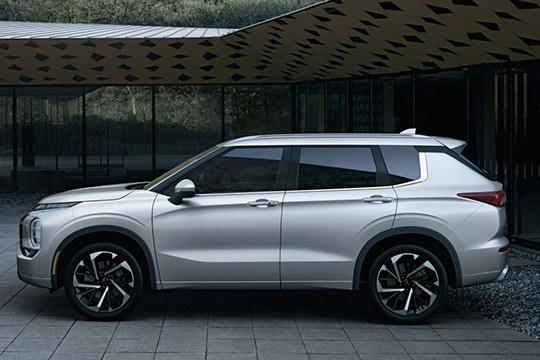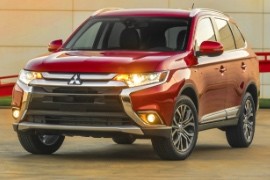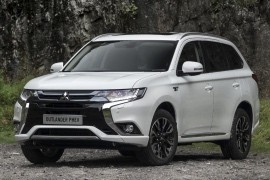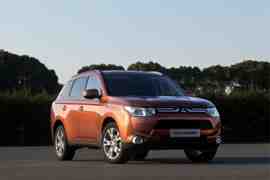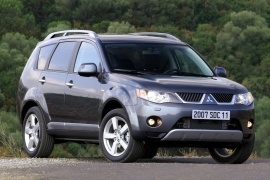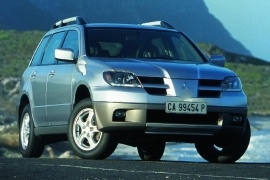MITSUBISHI Outlander / Airtrek Models/Series Timeline, Specifications & Photos
First production year: 2003
Engines: Gasoline, Mild hybrid, Diesel, Hybrid
Body style: SUV (Sports Utility Vehicle)
After joining the Renault-Nissan alliance, Mitsubishi received huge help from its former competitor and introduced the fourth generation of the Outlander in 2021.
Mitsubishi was caught off-guard by the 2007 world financial crisis and, even though it survived, it couldn't make a new lineup that could save the brand. Most of its vehicles were old, and, apart from the L200 pickup and the Outlander, the rest of the rang struggled to survive on the market. After a few troubled years, Mitsubishi ended up in the Renault-Nissan alliance, and the first new product developed together was the Outlander.
It was a new design language for Mitsubishi. The Outlander featured LED lights on top of the front fascia, with squared LED headlights mounted on the sides, above the bumper. Its broad, shield-like, chromed grille with three slats on the upper side and a black squared area were unusual for the Japanese brand. From its sides, the blacked-out B-pillar and the D-pillar shape gave the impression of a floating roof. Mitsubishi kept the split tailgate system that made it famous in the compact SUV segment.
While the exterior was flashy and daring but not luxurious, the interior was a different story. Depending on the trim level, the Outlander featured cloth or leather seats and a premium interior feeling. Its gear selector was small and placed on top of a tall center console. A large display filled the instrument cluster while an additional touch-screen made it on top of the dashboard, above the center stack. Like its predecessors, the Outlander's fourth-generation provided room for seven people, with two folding seats in the trunk.
At the launch, the Outlander was available exclusively with a newly developed 2.5-liter gasoline engine paired to a CVT that sent the power in all four corners.
Mitsubishi launched the 2016 model-year Outlander at the 2015 New York International Auto Show, trying to keep the well-known crossover image fresh.
The world financial crisis left Mitsubishi with empty pockets, and the Japanese automaker had no choice but to try to survive with refreshed older models. Moreover, it didn't have such a wide range of products anymore. Still, it had a few nameplates that could sell well, such as the Outlander, which was also known as Airtrek on the Japanese market, or Montero Outlander in South America.
There were not too many things to improve on this second facelift of the Outlander. Still, the automaker redesigned the front fascia and adorned the grille with a chromed surrounding. One essential update was for the headlights' design, which now sported an angular shape. In addition, the headlamps were swept around the corners and included the turn signals. From its profile, there were just tiny details that were changed, so the vehicle still looked like a jacked-up station wagon.
The interior design remained virtually unchanged, albeit with a new steering wheel. On the dashboard, the automaker installed the infotainment system (offered as an option) with its touchscreen placed on the center stack. One key element, though, was carried over successfully: the seven-passenger option. Even though those two jump seats from the trunk were small, they could accommodate two adults for short jaunts.
Underneath the hood, Mitsubishi installed a choice of engines depending on the market. Thus, in Europe, the Outlander was sold with a 2.2-liter turbo-diesel engine carried over from Citroen. In the U.S., on the other hand, it was offered with a 3.0-liter naturally aspirated V6.
The quest for cleaner vehicles but the desire for SUV vehicles was in the opposite direction. But the Mitsubishi figure-out a way to solve the problem with the Outlander PHEV.
The 2016 model of the Mitsubishi Outlander PHEV marked the second generation of the electrified SUV from the Japanese car-maker. It was unveiled at the 2016 New York International Auto Show. It was the answer not only for all of those who were looking for an ecological vehicle but also for all of those who were looking for a car good for everything.
The styling was upgraded when compared with its predecessor, with a new front fascia. Its appearance looked more modern, with some chromed details on and around the grille. The smaller headlights were available with LED light, which not only lights better, but they also are using less electricity to run. The rest of the car still looked like a jacked-up station-wagon.
Inside, there was enough room for up to five passengers. Unlike the older Outlander, which was available with seven seats, the PHEV had to carry the batteries and those are stored under the floor. There are 80 cells there and the 12kWh batteries take some space. Mitsubishi managed to install three true seats in the back, with enough legroom and headroom.
The PHEV stands Plug-in Hybrid Electric Vehicle. Basically, the car is intended to be charged at home and start the day with the batteries fully charged. On regular home-outlet power supply, that would take up to 5 hours.
The 2012 Mitsubishi Outlander came with a completely new model on the GS Platform developed together with the now defunct DaimlerChrysler. The Japanese carmaker tried to do a well-built SUV with up to seven seats and enough technology included to be an appealing car, but it forgot to pay for a better design team.
The first Outlander was built on a compact-size platform. This one is bigger and, with a 2.67-meter (105.1") long wheelbase and a transverse engine, has enough room for seven passengers. The last two are in the trunk and were large enough to fit two adults in the previous generation, but only children for this third generation.
Under the hood, there are three choices: 2.0-liter gasoline, a 2.2-liter turbodiesel, and a PHEV. The PHEV was, by far, the most interesting powertrain. It had a 2.0-liter gasoline engine and two 81 hp motors. The vehicle achieved a 52.3 km (32.5 miles) electric range from its 12 kWh batteries placed under the cabin, between the axles. The maximum speed in electric-only mode was 120 kph (74.5 mph).
The cabin was fitted with new technology for that year, including an infotainment unit able to connect to Apple CarPlay and Android Auto. The middle row has a sliding and adjustable backrest to help access to the third row and improve mid-row passengers comfort.
Mitsubishi built the second generation of the Outlander in Europe together with the French group PSA (Peugeot-Citroen) and took a diesel engine from Volkswagen.
After five years on the market, Mitsubishi dropped the first generation of the Outlander, and the second generation was unveiled in October 2006. It was built as a world car and adapted for specific markets. To prove that, Mitsubishi dropped the Airtrek nameplate from the Japanese market and use the Outlander, like in the rest of the world.
The car's design was a mix of angular lines and curved panels. It sported glass-covered headlights and a split grille. Depending on the trim level, it featured an aluminum shield under the apron, protecting the engine and the gearbox. In the back, Mitsubishi installed a set of clear taillights with LED-like lamps inside. The carmaker chose a split opening system with the top side going upwards and the bottom being lowered when opened for the tailgate.
Inside, the Outlander offered room for seven in a 2-3-2 configuration. While the last row was not very comfortable, it could host two adults for short distances. At the front, the carmaker installed a dashboard inspired by the Lancer, with a binocular-style instrument cluster. Depending on the transmission, the carmaker installed paddle-shifters for the automatic gearbox versions and a rotary knob for the transmission switching the car between front-wheel-drive and all-wheel-drive with an option for a locking center differential.
Under the hood, Mitsubishi installed a choice of three engines: two with gasoline and one turbodiesel. The latter was a 2.0-liter TDI from Volkswagen.
Mitsubishi noticed the increased demand for compact SUVs, and since it was a renowned manufacturer of full-size 4x4 vehicles, it introduced the Airtrek/Outlander on the market in 2001.
While at first, it was available just in Japan and sold under the Airtrek nameplate, and two years later, it was exported to North America and Europe. The vehicle was built on top of the same platform as the Lancer so that it could accommodate an all-wheel drive system. It was a shy start for this model that, later on, became one of the carmaker's most successful products.
The first generation of the Outlander looked like a high-rider station wagon. It featured a front end with car-like, swept-back headlights and a grill that sported a wide center area where the carmaker's badge took center stage. The tall door panels forced the automaker to use smaller-sized side windows, similar to those met in a regular sedan. But that didn't stop the automaker from creating a tilted-forward tailgate, offering a dynamic image for the vehicle.
Inside, the Outlander offered a high-seating position compared to a regular station wagon. That led to a tall dashboard with an extended center stack that housed the HVAC and the audio controls. Above it, Mitsubishi installed a regular analog clock, which was considered a stylish detail. Fronting the driver was the instrument cluster where the carmaker placed the large dials for the speedometer and tachometer, with two additional gauges between them for the fuel level and water temperature.
Featuring only inline-four gasoline engines, with or without a turbocharger, the Airtrek/Outlander became a constant presence on the streets. After all, the carmaker was reckoned for its reliable vehicles.
